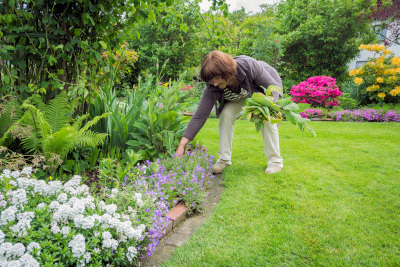
one
two
three


Weeds can really cause a problem in landscape beds. They take water, nutrients, and space away from the plants you put there. They also look bad.

What Is A Weed?
A weed is any plant that is growing where you do not want it to grow. Generally, it is a plant whose seeds are brought by the wind or by an animal to your landscape. If the seed ends up in a place that meets its requirements, the seed germinates. It only takes a little organic matter for some weed seeds to germinate, while others are pickier.
Preventing Weeds
There are several ways to control weeds. The best way to control them is to keep them from ever growing.
Mulch looks nice, but it also helps keep your landscape beds free of weeds. When a weed germinates, it grows up toward the light. It has to reach the light before the energy in the seed is exhausted. Here is where the mulch comes in. With a 3–4-inch layer of mulch, the seed runs out of energy before it reaches the light and dies. Mulch also retains water and gives it back to your plants when they are dry. It insulates the plant roots. The mulch will need to be topped off every year with about an inch of mulch as the bottom layer decays during the year and delivers a slow nitrogen fertilizer to the plant roots.
Pre-emergent This product forms a layer in the soil. As the seeds hit that layer, it is poisoned and dies. You can apply a pre-emergent more than once a season. Pre-emergent is not as effective in the late fall and winter when the temperature drops. It only works on things growing, not on things going into dormancy. One word of caution: Don’t put pre-emergent anywhere you are planting seeds, as it will kill them. This happens in vegetable gardens as well as in flower beds and grassy areas.
Weed Barrier Fabric is laid down when the bed is first established. It is often made of polypropylene or linen and has small holes so water, nutrients, and oxygen can reach the roots. This fabric physically blocks seeds from the light. They run out of energy and die. After the fabric is laid, slits are cut to plant the landscape plants. One word of caution: Do not place mulch on this fabric. The mulch will decompose and become organic matter that will germinate seeds as well as rot out the fabric over time. Use decorative rocks to cover the weed barrier fabric instead.
Maintaining Rock Beds means cleaning leaves and other blown debris out of your rock bed. Otherwise, the debris will settle in the gaps and form a place for weed seeds to grow. Most people use a blower or a vacuum for this.
Killing Weeds
Once weed seeds are seen, it is too late for prevention. Now you have to eradicate the resulting weeds. There are several ways to do this.
Hand Pulling is a good way to get rid of the weeds while they are still small. If you are to be effective, you must get all the roots. If roots are left behind, the weed will come back. Every landscape bed should be weeded at least once a month. Weekly is better if the size of the landscape permits it. Remember, the smaller they are when you pull them out, the easier they come out. If you are going to weed a bed when it is dry outside, you should water it the day before, so the weed comes out easier.
Herbicides are another method to kill weeds. There are selective herbicides and broad herbicides. A selective herbicide is one like 2,4,D. It only kills broadleaf plants. Because most landscape beds are full of broadleaf plants, it is usually used on Bermuda grass to kill the weeds in the lawn without killing the Bermuda grass. A broad herbicide will kill anything it touches. Many people are familiar with Round-Up. It is a broad herbicide. Be careful when using herbicides around ponds, as they are toxic to aquatic life.
If you choose to use an herbicide, make sure you follow the directions on the label. More is not better. It is a federal law that you must use the herbicide in a manner consistent with the label. You should wear long sleeves, long pants, gloves, and closed-toe shoes when using these products. There has been some research suggesting glyphosate, the active ingredient in Round-Up and other broad herbicides, causes cancer. The Environmental Protection Agency (EPA) has said it is safe to use if the instructions on the label are followed.
Let The Professionals Do The Work
Killing weeds can be a lot of work, especially if they have been neglected. Royal Creations Architectural Landscaping can do that for you. We can do a one-time clean-up, useful if the landscape has been neglected by a previous owner, or we can do regular maintenance. Let us know if you need help keeping your landscape weed-free. Contact Royal Creations Architectural Landscaping today so you can enjoy your landscaping, not the weeds.